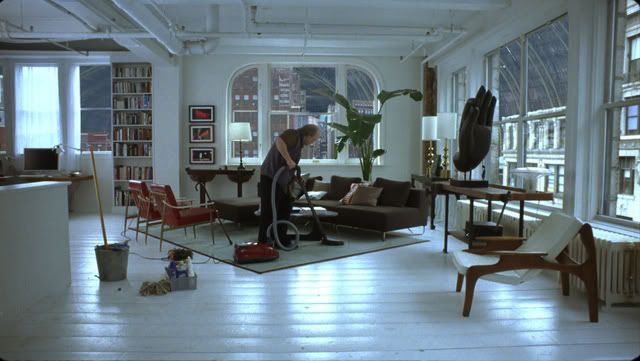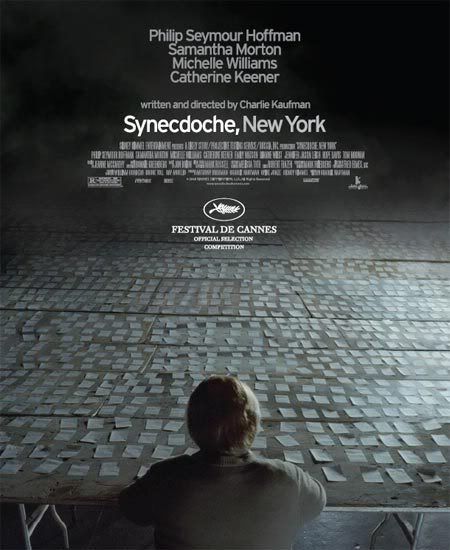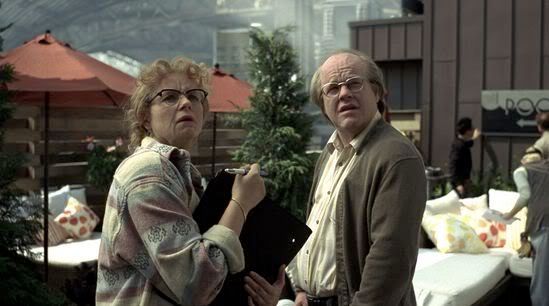Brief and Preliminary Thoughts on Complications in Synecdoche, New York (and Myself?)
by Mark Haslam
[Note: I guess we were wrong on our podcast: Synecdoche, New York opens in limited release in NY/LA October 24th, with a roll out schedule to follow, thanks to Sony Picture Classics. Still, Mark has successfully avoided spoilers.]

Synecdoche, New York had always seemed to me a great title. Not because of the claims it may make about film or image as inherently synecdochic or metonymic, which does seem just a bit easy, if not facile; rather, I liked it because of the simple play it makes on Schenectady, one that had never occurred to me. (Not like I sit around thinking up every pun possible, but while I'm at it, here's one I kinda dig on: 'fiancee' and 'faience'.) In light of the title, we have to think, in part, of place as a part of its inhabitant, as a part of a person's whole. Here, a place is not made up of humans, or not just, but a human is made up of, among other things, place. The film solidifies this in its presentation of the title, which appears subtilely at the bottom of the screen, as though a mere identification of setting. So 'Synecdoche' is not just a joke about 'Schenectady': synecdoche is the location: the location is representation. It makes sense, then, that Caden Cotard (Phillip Semore Hoffman), the film's protagonist, would spend a majority of his time in (re)building his surroundings as a means of creating something “personal,” a massive self-portrait. The act itself—of building and constructing; of acting in the first place, of performing—is fundamental to the creation of self. However it's also alienating and exclusionary: all relations that aren't Myself and My City are diverted away ('fiancee'/'faience'?). Caden can't commit and can't keep his women from slipping away, obscuring, then dying.
 One of the more interesting or, and I hesitate to use this word but here goes, risky elements of Synecdoche is a burning house that nobody seems to recognize as having anything particularly wrong with it. In fact, it's inhabited by Caden's secretary and on-again/off-again lover, Hazel (Samantha Morton). It's the sort of thing that's funny-ish in concept, but (here's why I used it) risks becoming nothing more than Signifier. A house on fire, in this case, could only have meaning. But then Kauffman returns to the burning house, pursues it, prolongs our experience of it—it isn't just a gag, it reappears several times, always in a modified context—almost to the extent that whatever meaning we gave it is emptied out, so that what we see is the inhabitation of a Signifier, much like the process enacted by the title.
One of the more interesting or, and I hesitate to use this word but here goes, risky elements of Synecdoche is a burning house that nobody seems to recognize as having anything particularly wrong with it. In fact, it's inhabited by Caden's secretary and on-again/off-again lover, Hazel (Samantha Morton). It's the sort of thing that's funny-ish in concept, but (here's why I used it) risks becoming nothing more than Signifier. A house on fire, in this case, could only have meaning. But then Kauffman returns to the burning house, pursues it, prolongs our experience of it—it isn't just a gag, it reappears several times, always in a modified context—almost to the extent that whatever meaning we gave it is emptied out, so that what we see is the inhabitation of a Signifier, much like the process enacted by the title.Yet Kauffman only “almost” does this. I mean, he does it, but it gets obscured by everything else he does. (Which doesn't even raise the question, If he hadn't done it, would it be there anyway simply because of the nature of film?) For as much as the film is about building and/as solipsism, it's about time, which like relationships keep slipping away, and death, whose approach never falters. Both are portrayed in a particularly Kauffmanesque structuration, which can jump decades without a flinch. But where this technique was successful in Eternal Sunshine, it's not so much here, because we rely on overt cues to tell us we've performed this temopal leap—things like, “It's been sixteen years.” The structure itself doesn't really communicate the idea of time, and so we feel lost. And it's not a good kind of lost.
Especially given that structures and their construction are such a major part of the film, it's hard to not see this as at best a missed opportunity, at worst as evidence of Synecdoche's ultimate failure: that it doesn't utilize form. No doubt, it's got some great ideas, ideas about space and time which seem natural to film; but they're not put together in any cohesive way. Things are jumbled, uneven. Leaving the theater, I couldn't escape the thought of what would've been if Kauffman had given things more time, allowed the form to unfold itself, gradually over time, so that we feel time slipping away from us as it slips away from Caden, so that the approach of the film's end really is that gradual approach of Death.





No comments:
Post a Comment